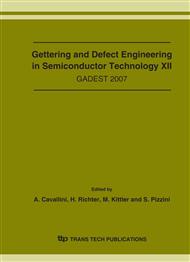p.461
p.467
p.473
p.479
p.485
p.491
p.497
p.503
p.511
DLTS and PR Studies of Partially Relaxed InGaAs/GaAs Heterostructures Grown by MOVPE
Abstract:
The studies of electrical activity of deep electron traps and the optical response of partially-strain relaxed InxGa1-xAs layers (x=5.5%, 7.7% and 8.6%) grown by metalorganic vapourphase epitaxy (MOVPE) have been performed by means of deep-level transient spectroscopy (DLTS) and photoreflectance (PR). DLTS measurements revealed two electron traps. One of the trap has been attributed to electron states at α-type misfit dislocations. The other trap has been ascribed to the EL2 point defect. The PR spectra at room temperature were measured and analysed. By applying the results of theoretical calculations which include excitonic and strain effects, we were able to estimate the extent of strain relaxation and the values of residual strain in the partially relaxed epitaxial layers.
Info:
Periodical:
Pages:
485-490
Citation:
Online since:
October 2007
Keywords:
Price:
Сopyright:
© 2008 Trans Tech Publications Ltd. All Rights Reserved
Share:
Citation:


